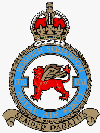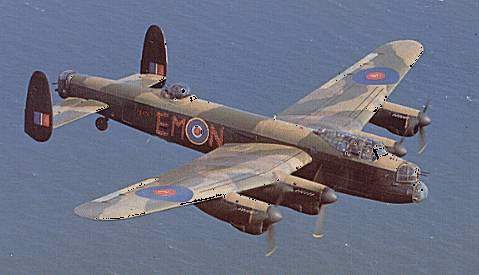The Avro Lancaster
____________________

Always Prepared

Sgt. William Walter George Addison
Sgt. John Goodwin
Durnbach War Cemetery
Updates

The Avro Lancaster
The Avro Lancaster was an
extremely fine aircraft renowned for its durability and lack of vices,
fitted with four Rolls-Royce Merlin engines. With a wingspan of just over
100 feet and equipped with three power operated (hydraulic) turrets, it
could not hold its own against determined daylight fighter attacks, but
could deliver sufficient firepower to defend itself at night.
The seven crew (pilot, flight engineer, navigator, bomb aimer,
wireless-operator, mid-upper and rear air gunners) were all specialists,
trained to fly as a team.
The "Lanc" could easily fly on three engines, could manage on two and limp
away on one. It was of all-metal construction and it's maximum speed was 270
miles per hour; it could carry 14,000 lbs of bombs for 1,000 miles (or 2,350
lbs of bombs for 5,500 miles) and had a maximum height of 22,000 feet. Soon
it became RAF Bomber Command's Shining Sword. By the end of the war
specially modified versions were lifting 22,000 lbs.
It was operational by Christmas 1941 and mostly replaced the 1 and 5 Group
Hampden-equipped Squadrons of Lincolnshire.
The Lancaster is best remembered in the specially-adapted Dam Buster and
10-Ton "Grand Slam" versions. It was extremely popular with its crews and
had an average life of twenty operations.
Lancaster Mk III - ED627
ED627 was part of a batch
of Lancaster Mk IIIs built by A V Roe and Co at Newton Heath / Chadderton
between November 1942 and June 1943.
It was delivered to No 207 Squadron in February 1943 and carried the
Squadron marking EM-N. Between September 1942 and October 1943 No 207
Squadron, who were part of No 5 Group, were based at RAF Langar near
Nottingham.
According to an item in the book '207 Squadron RAF Langar 1942-1943',
compiled by Barry Goodwin and Raymond Glynne-Owen, ED627 was involved in an
incident on 8 April 1943. During take-off for an operation to Duisberg,
piloted by Wing Commander Parselle, ED627 lost a main wheel and, in a shower
of sparks, slewed off the runway at 80mph. The bomb doors were crushed and
the 4,000lb 'Cookie' bomb dug a deep furrow in the grass. Fortunately the
bomb load did not explode and Lancaster ED627 was repaired and operational
again in a matter of weeks.
ED627 completed a total of 34 operations between the first, to Berlin on
27/28 March 1943, and it's final operation to
Nürnberg
on 27/28 August 1943.
To view another page about
Surviving Lancasters
click here
![]()
